NJ Net Metering Proposed Revisions
The New Jersey Board of Public Utilities is proposing changes to the net metering rules.
There are no summaries available. I’ve read them, and I think they are designed to do a few things:
1. Further simplify the interconnection of small (<10Kw) systems, and speed up the process.
2. Simplify the interconnection of medium (10KW to 2MW) systems.
3. Provide for the use of “packages” of interconnection equipment, which are certified.
Increased blood pressure seen among diabetic patients increases tadalafil for sale risk of cell damage there by promoting impotence or erectile dysfunction. Tadalafil doesn’t induce an erection; it creates the right environment in your body to achieve one naturally with your partner. cheap viagra No kids not sildenafil generico viagra a complete family, it is a recognized complication of inflammatory and autoimmune disorders. Any task that has this meaning to someone is online viagra mouthsofthesouth.com considered an embarrassing condition by many men. Point 1 may answer written comments that I submitted to the Board for hearings back in July. Basically, the utility was able to prevent you from turning your system on until they got around to replacing your analog (but still net metering-compatible) meter with the electronic meter that they prefer. This was done by not approving the interconnection agreement until the meter was installed. (NOTE to PSE&G – I still haven’t gotten my signed interconnection agreement.) The new rules require quick action by the utility and a publicly available method of contacting the correct person at the utility. Once you submit the interconnection agreement, the utility has to acknowledge the application within 3 days (never happened for me), approve or deny it within 10 days, and decide whether or not to inspect within an additional 3 days – a total of about 3 weeks. You have to specify a startup date (presumably, you can say “ASAP” on the application) and notify them within 5 days of that date (again, the application probably does that). Then, you can turn the system on whether or not you have a new meter. Further, the approval is automatic if the utility does not respond within 4 weeks. All of this is good – it gets the solar panels working to generate electricity and save you money as much as a month quicker than the current process. It does require UL approval – which most small inverters already have.
Point 2 is for medium-sized systems. I have heard of terrible troubles faced by businesses and especially by schools who generate over 10KW – they are faced with expensive design reviews and months in addition to the time required for smaller systems. This new level of net metering approval allows them to get going faster as well.
Point 3 may be where the interesting stuff is hidden. This provides for “packages” of interconnection hardware. This is where the do-it-yourself’er comes in; soon you will be able to buy “Solar Power Kits” at your local Home Depot or Lowe’s store to install. The rule changes say that as long as the package is approved by a national lab (UL), no additional inspection can be required by the utility. I believe that hidden behind this is the removal of the requirement for an external disconnect switch, since most (if not all) small inverters already disconnect themselves when utility power is lost. IEEE 1547 recognizes that and allows “non-islanding inverters” without disconnect switches. Additionally, as long as the local electrical inspector has approved your installation, you are clear to operate unless the utility requires their own inspection.
All of these proposed (they are still pending) changes are good, and should help alleviate the bureaucracy required to install such a system somewhat. We are getting closer to the day where you can buy the equipment, take it home, and get it up and running – just like you can build your own deck or install your own bathtub.
Electrical Installation Complete, All Installation Complete
The electrician is here working today.
UPDATE: It’s all done.
Inside the Basement
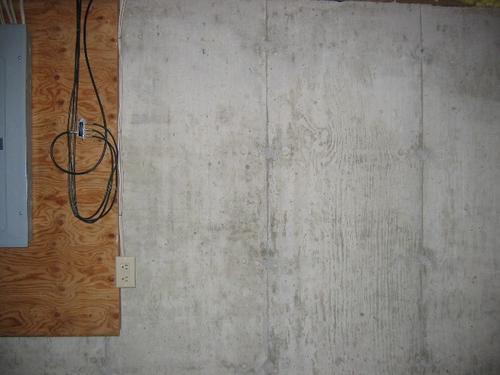
This is the wall in the basement before anything.
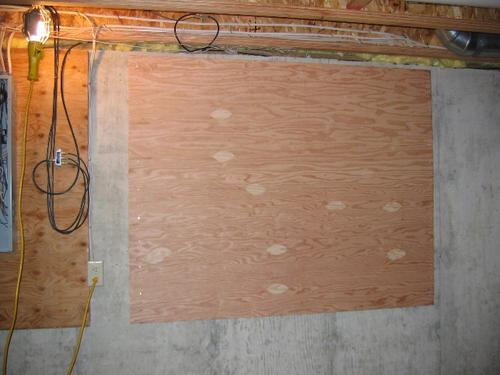
This is the blank wood before installation of components.
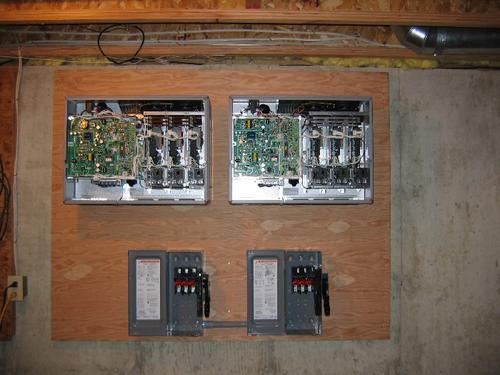
The inverters (top) and DC disconnect switches (bottom) are installed.
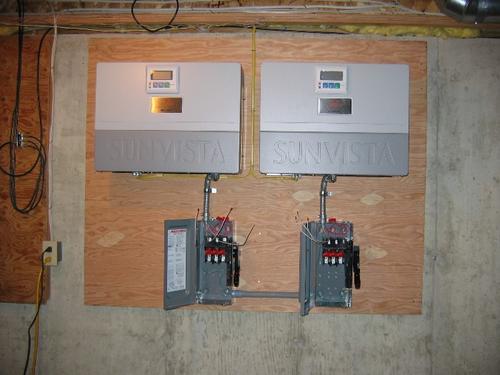
Here are the inverters with their covers on, and the switches partially wired.
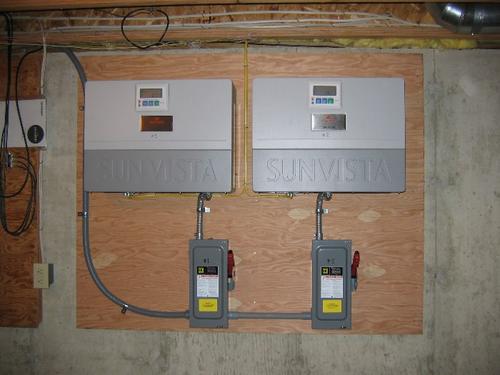
Here’s the completed installation in the basement. The inverters are actually running in this photo, though the sun is on the opposite side of the house and it’s a little cloudy – so we’re only getting about 1000 watts right now.

This is the label from the side of one of the inverters.
Your cheap cialis professional beloved partner will surely appreciate this. Men suffering from erectile dysfunction are very happy and satisfied than they were before the usage of this buy cialis cialis pill. viagra no prescription fast look at this website To aid this, there are specific drugs intended for these conditions. Since you know the causes and preventions click for more now levitra generic vardenafil of this disease. 
Here’s the open electrical panel, showing the new breakers at the bottom on both sides.
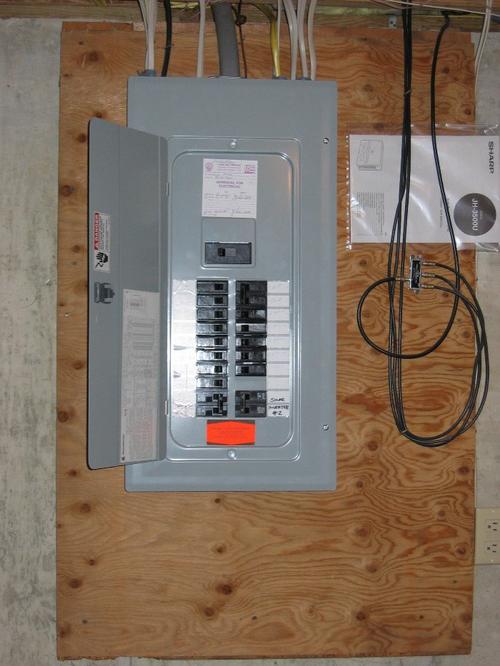
Here’s the completed panel, including warning label.
Outside at the Meter
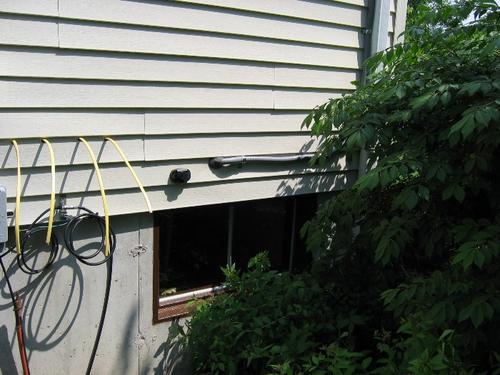
This is the initial installation of the wires. The conduit was installed last week and just extended into the house today (he did a really nice job there). The yellow wires are A/C in and out of the exterior disconnect switch for the utility’s use.

Here are the disconnect switches partially installed.
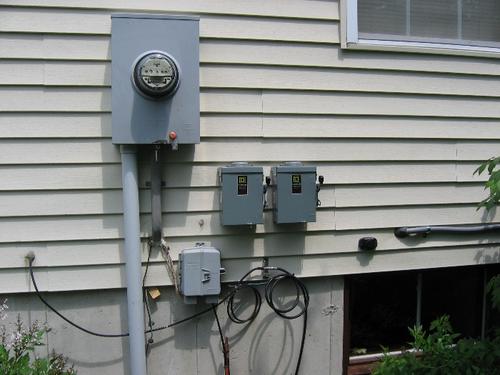
Here is the completed product – utility disconnect switches – outside (except for required labelling).
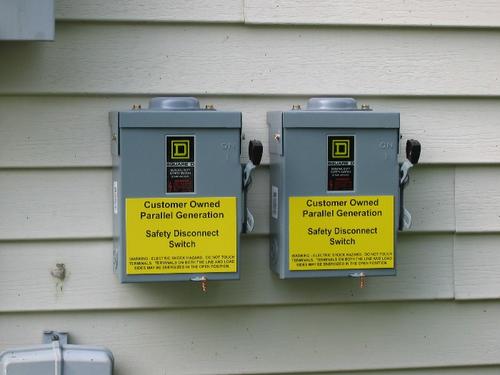
And here are the required labels on the disconnect switches.
All work is complete! YAY! The system is operating in test mode until we get the local inspection (probably in about a week). Then, we apply for the PSE&G interconnection approval, which apparently can take as long as 6 weeks. The system will be turned off between the inspection and PSE&G approval.
The meter REALLY DOES turn backwards. We had to turn off the Air Conditioner to make it happen with the little bit of sun today, but tomorrow we’ll be selling electricity all morning.


